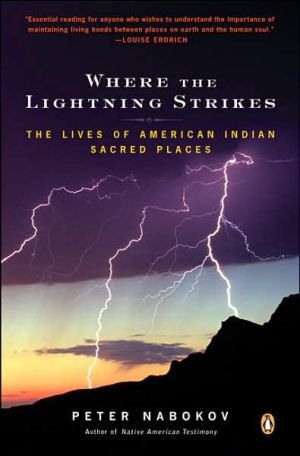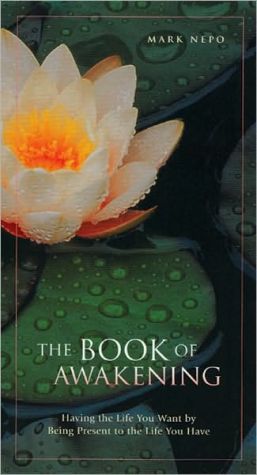Where the Lightning Strikes: The Lives of American Indian Sacred Places
A revelatory new look at the hallowed, diverse, and threatened landscapes of the American Indian\ For thousands of years , Native Americans have told stories about the powers of revered landscapes and sought spiritual direction at mysterious places in their homelands. In this important book, respected scholar and anthropologist Peter Nabokov writes of a wide range of sacred places in Native America. From the “high country” of California to Tennessee’s Tellico Valley, from the Black Hills of...
Search in google:
A revelatory new look at the hallowed, diverse, and threatened landscapes of the American Indian For thousands of years , Native Americans have told stories about the powers of revered landscapes and sought spiritual direction at mysterious places in their homelands. In this important book, respected scholar and anthropologist Peter Nabokov writes of a wide range of sacred places in Native America. From the “high country” of California to Tennessee's Tellico Valley, from the Black Hills of South Dakota to Rainbow Canyon in Arizona, each chapter delves into the relationship between Indian cultures and their environments and describes the myths and legends, practices, and rituals that sustained them. Publishers Weekly According to UCLA professor Nabokov (Native American Testimony), the places that American Indians call sacred may be as wondrous as "cliffs spilling with waterfalls" and as humble as "caves splattered with bat excrement." What makes them important is not postcard-perfect beauty but the beliefs a group has about "what lies within or beneath what the eye can see." This excellent volume presents the "biographies" of 16 such places, from Maine to California. Through them, Nabokov surveys a wide range of Native American spiritual practices and reveals how intrusions into Native Americans' land have also constituted assaults upon their religious beliefs. Indeed, many of the assaults continue to this day: after the disruptions caused by war, disease, missionary activity and forced relocation came those of hydroelectric dams, agribusiness, parking lots and extreme sports buffs. Nabokov's deeply informed text is enhanced by first-person accounts of his visits to the locations and by his spirited commentary on the writings of other ethnographers, naturalists, linguists and anthropologists. Sentimental cliches and monolithic views are dismantled along the way. Each of Nabokov's biographies can be savored separately; taken together, they demonstrate both that there is "more to some American places than [meets] the eye" and that Native Americans have known that for a very long time. (Jan.) Copyright 2005 Reed Business Information.
Ch. 1Worlds in an island - Penobscot3Ch. 2Naming the spirits - Ojibwa20Ch. 3Hills of hidden meaning - Choctaw35Ch. 4Between river and fire - Cherokee52Ch. 5A tale of three lakes - Taos/Zuni73Ch. 6Place as personal - Navajo/Apache91Ch. 7Christ in the flower world - Yaqui111Ch. 8Draining the sacred places - Hopi129Ch. 9A geology of power - Plateau149Ch. 10Priestly skies, shamanic Earth - Pawnee169Ch. 11Journeys to promised lands - Hidatsa/Crow188Ch. 12The heart of everything - Lakota/Cheyenne/Klowa206Ch. 13Singing the origins - Colorado River225Ch. 14Beyond the goddess - Southern California244Ch. 15Where mountains congregate - Central California264Ch. 16Mourning and renewal - Northern California283
\ Publishers WeeklyAccording to UCLA professor Nabokov (Native American Testimony), the places that American Indians call sacred may be as wondrous as "cliffs spilling with waterfalls" and as humble as "caves splattered with bat excrement." What makes them important is not postcard-perfect beauty but the beliefs a group has about "what lies within or beneath what the eye can see." This excellent volume presents the "biographies" of 16 such places, from Maine to California. Through them, Nabokov surveys a wide range of Native American spiritual practices and reveals how intrusions into Native Americans' land have also constituted assaults upon their religious beliefs. Indeed, many of the assaults continue to this day: after the disruptions caused by war, disease, missionary activity and forced relocation came those of hydroelectric dams, agribusiness, parking lots and extreme sports buffs. Nabokov's deeply informed text is enhanced by first-person accounts of his visits to the locations and by his spirited commentary on the writings of other ethnographers, naturalists, linguists and anthropologists. Sentimental cliches and monolithic views are dismantled along the way. Each of Nabokov's biographies can be savored separately; taken together, they demonstrate both that there is "more to some American places than [meets] the eye" and that Native Americans have known that for a very long time. (Jan.) Copyright 2005 Reed Business Information.\ \ \ \ \ Library JournalWhat makes a location sacred to a particular group of people? Nabokov (American Indian studies, World Arts and Cultures, UCLA; A Forest of Time: American Indian Ways of History) probes the depths of this question in his sensitive examination of the relationship between Native American spirituality and physical geography. Nabokov provides profiles of 16 distinct American Indian holy places in different areas of the United States. His skilled narrative explores the wide diversity of Native American beliefs concerning the earth, the land, and special locations in each unique environment. The profiles are grouped into four sections, each of which has as its theme a relatively recent United States court case in which American Indian rights to certain sacred places were removed or limited. Some of these cases involved the construction of dams that completely destroyed important Native American sacred sites. Nabokov does a masterly job of exploring the numinous balance between the American Indian sense of place and sense of the sacred while being careful not to intrude upon aspects of Native American spirituality that should remain private. His work is thought-provoking, poignant, and evocative. Highly recommended for anthropology and American Indian studies collections in academic and large public libraries.-Elizabeth Salt, Otterbein Coll. Lib., Westerville, OH Copyright 2005 Reed Business Information.\ \








